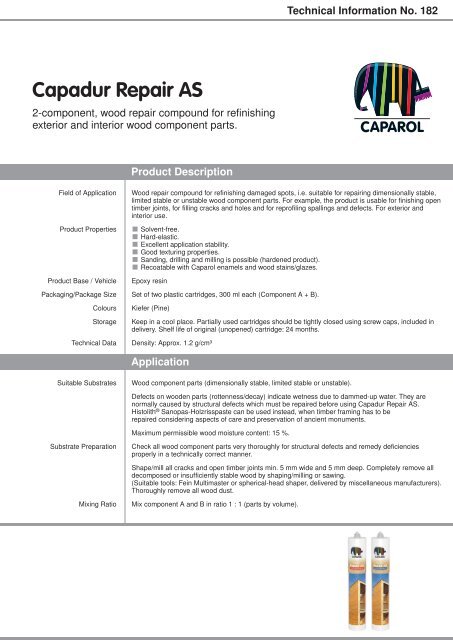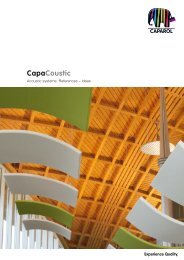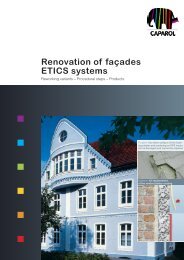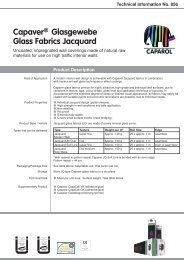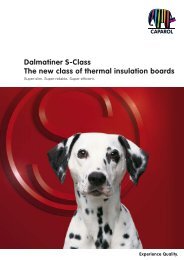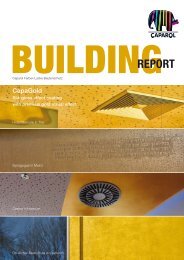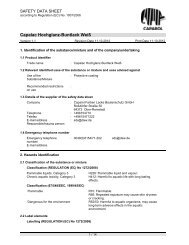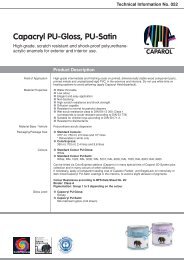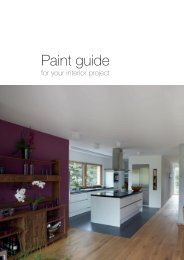Capadur Repair AS - Caparol
Capadur Repair AS - Caparol
Capadur Repair AS - Caparol
Create successful ePaper yourself
Turn your PDF publications into a flip-book with our unique Google optimized e-Paper software.
<strong>Capadur</strong> <strong>Repair</strong> <strong>AS</strong><br />
2-component, wood repair compound for refinishing<br />
exterior and interior wood component parts.<br />
Field of Application<br />
Product Properties<br />
Product Base / Vehicle<br />
Packaging/Package Size<br />
Colours<br />
Storage<br />
Technical Data<br />
Suitable Substrates<br />
Substrate Preparation<br />
Mixing Ratio<br />
Product Description<br />
Technical Information No. 182<br />
Wood repair compound for refinishing damaged spots, i.e. suitable for repairing dimensionally stable,<br />
limited stable or unstable wood component parts. For example, the product is usable for finishing open<br />
timber joints, for filling cracks and holes and for reprofiling spallings and defects. For exterior and<br />
interior use.<br />
■ Solvent-free.<br />
■ Hard-elastic.<br />
■ Excellent application stability.<br />
■ Good texturing properties.<br />
■ Sanding, drilling and milling is possible (hardened product).<br />
■ Recoatable with <strong>Caparol</strong> enamels and wood stains/glazes.<br />
Epoxy resin<br />
Set of two plastic cartridges, 300 ml each (Component A + B).<br />
Kiefer (Pine)<br />
Keep in a cool place. Partially used cartridges should be tightly closed using screw caps, included in<br />
delivery. Shelf life of original (unopened) cartridge: 24 months.<br />
Density: Approx. 1.2 g/cm³<br />
Application<br />
Wood component parts (dimensionally stable, limited stable or unstable).<br />
Defects on wooden parts (rottenness/decay) indicate wetness due to dammed-up water. They are<br />
normally caused by structural defects which must be repaired before using <strong>Capadur</strong> <strong>Repair</strong> <strong>AS</strong>.<br />
Histolith ® Sanopas-Holzrisspaste can be used instead, when timber framing has to be<br />
repaired considering aspects of care and preservation of ancient monuments.<br />
Maximum permissible wood moisture content: 15 %.<br />
Check all wood component parts very thoroughly for structural defects and remedy deficiencies<br />
properly in a technically correct manner.<br />
Shape/mill all cracks and open timber joints min. 5 mm wide and 5 mm deep. Completely remove all<br />
decomposed or insufficiently stable wood by shaping/milling or sawing.<br />
(Suitable tools: Fein Multimaster or spherical-head shaper, delivered by miscellaneous manufacturers).<br />
Thoroughly remove all wood dust.<br />
Mix component A and B in ratio 1 : 1 (parts by volume).
Method of Application<br />
Workability<br />
Application Conditions<br />
Drying/Drying Time<br />
Tool Cleaning<br />
Special Risks (Hazard Note) / Safety<br />
Advice (Status as at Date of<br />
Publication)<br />
Disposal<br />
Giscode<br />
Technical Information No. 182<br />
Mixing: Cut cartridges above thread of screw and insert both cartridges (component A + B) in a<br />
suitable dual cartridge caulking gun. Alternatively two normal caulking guns can be used. Press two<br />
threads of component A + B in same length and required quantity onto a board, side by side, and<br />
close the cartridges using delivered threaded caps.<br />
Mix both components thoroughly with a scraper, until a homogeneously coloured and streak-free wood<br />
repair compound is achieved.<br />
Note: Always use a board for mixing in order to prevent blistering by pressing out all air cells/bubbles<br />
with the scraper. Do not amass the filling compound on the (mixing) board but spead out.<br />
Accumulation of mixed product will cause a diminished pot life due to heat of reaction.<br />
Application: Impregnate defective areas with <strong>Capadur</strong> <strong>Repair</strong> P. Allow the primer to flash off for min.<br />
20 minutes (but no longer than max. 2 hours), then apply wood repair compound <strong>Capadur</strong> <strong>Repair</strong> <strong>AS</strong><br />
onto the primer. Note: The primer must not be moist. Remove all excess product with a cloth.<br />
In a first working step apply a fine layer of <strong>Capadur</strong> <strong>Repair</strong> <strong>AS</strong> onto the wood surface by scraper, in<br />
order to achieve a proper wetting (grip/adhesion). Then fill the defect with <strong>Capadur</strong> <strong>Repair</strong> <strong>AS</strong>. Fill<br />
deeper defects wet on wet in layers of max. 5 mm. Thus a proper densification is obtained and<br />
blistering is avoided. Fill all defects with a little overspill. Excess product can be sanded the next<br />
day flush to the surface, at the earliest after 16 hrs. (at 20 °C and 60 % relative humidity).<br />
Fill the repair compound with fitted bits of wood, when repairing large defects. Take care to provide for<br />
a min. 5 mm wide joint of repair compound on all sides between the filling bits of wood and the wood<br />
component part. Prime all contact surfaces with <strong>Capadur</strong> <strong>Repair</strong> P and, after a flash off time of 20<br />
minutes (2 hrs. at the latest), apply <strong>Capadur</strong> <strong>Repair</strong> <strong>AS</strong> onto the full surface. Lay in all bits of wood<br />
avoiding blistering and remove all excess product with a scraper.<br />
<strong>Capadur</strong> <strong>Repair</strong> <strong>AS</strong> is no spackling compound (putty/body filler/surfacer)!<br />
<strong>Repair</strong> patches must be min. 5 mm deep and wide (minimum layer thickness).<br />
Thoroughly sanded surfaces can be coated with <strong>Caparol</strong> enamels and wood stains/glazes.<br />
Always check for compatibility, when products of other manufacturers are used.<br />
Pot (working) life: Approx. 30 minutes at 20 °C air temperature. Pot life is shortened at higher<br />
temperatures. Avoid application under a glaring sun (on sun-heated surfaces).<br />
Processing temperature during application & curing: Min. 10 °C up to max. 30 °C (substrate, product<br />
and ambient air). Maximum permissible relative humidity: 85 %.<br />
Drying/curing times at 20 °C and 60 % RH:<br />
Dust-dry after approx. 4 hours.<br />
Sanding/grinding is possible after approx. 16 hours.<br />
Recoatable after approx. 16 hours.<br />
Chemical and mechanical loadability (fully cured) after approx. 7 days.<br />
With special cleaning wipes or with Disboxid 419 Verdünner (thinner).<br />
Advice<br />
Component A (Base material):<br />
For professional use only.<br />
Causes skin irritation. May cause an allergic skin reaction. Causes serious eye irritation. Toxic to<br />
aquatic life with long lasting effects. Do not breathe vapours/ spray. Do not get in eyes, on skin, or on<br />
clothing. Avoid release to the environment. Use personal protective equipment as required. Rinse<br />
cautiously with water for several minutes. Remove contact lenses, if present and easy to do. Continue<br />
rinsing. Wash with plenty of soap and water. Store in a well-ventilated place. Keep container tightly<br />
closed. Dispose of contents/ container to an approved waste disposal plant. Contains epoxy<br />
constituents. May produce an allergic reaction.<br />
Component B (Hardener/Catalyst):<br />
For professional use only.<br />
Harmful if swallowed. Causes severe skin burns and eye damage. May cause an allergic skin reaction.<br />
Do not breathe dust/ fume/ gas/ mist/ vapours/ spray. Do not get in eyes, on skin, or on clothing. Avoid<br />
release to the environment. Use personal protective equipment as required. IF IN EYES: Rinse<br />
cautiously with water for several minutes. Remove contact lenses, if present and easy to do. Continue<br />
rinsing. IF ON SKIN: Wash with plenty of soap and water. Take off contaminated clothing and wash<br />
before reuse. Store in a well-ventilated place. Keep container tightly closed. Dispose of contents/<br />
container to an approved waste disposal plant.<br />
Materials and all related packaging must be disposed of in a safe way in accordance with the full<br />
requirements of the local authority. Particular attention should be made to removing wastage from site<br />
in compliance with standard construction site procedures.<br />
In Germany: Only completely emptied cartridges must be given for recycling. Product residues: Allow<br />
curing of base material with hardener (components A + B) and dispose of as paints waste.<br />
RE1
Further Details<br />
Customer Service Centre<br />
Technical Information No. 182 · Issue: March 2013<br />
See Material Safety Data Sheet (MSDS).<br />
Tel.: 06154 / 711710<br />
Fax: 06154 / 711711<br />
E-Mail: kundenservicecenter@caparol.de<br />
International Distribution: Please see www.caparol.com<br />
Technical Information No. 182<br />
All suggestions and application instructions herein are based on our latest technical experience. Due to the wide variety of individual project conditions, we cannot be held responsible for their content. These instructions do not release the purchaser/<br />
applicator from his responsibility to determine the suitability of the product in consideration of the project characteristics. These instructions are to be considered void when a new edition is released. Our general conditions of sale and delivery in their<br />
latest edition apply. This document is a translation of our German Technical Information No. 182 · <strong>Capadur</strong> <strong>Repair</strong> <strong>AS</strong> · Issued: February 2013<br />
DAW International Business: Deutsche Amphibolin-Werke von Robert Murjahn Stiftung & Co KG · P.O.B. 1264 · D-64369 Ober-Ramstadt · Tel. +49 6154 71-1274<br />
Fax +49 6154 71-1264 · Internet www.caparol.com


